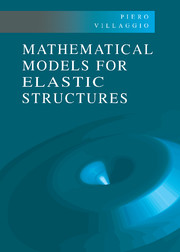
-
Select format
-
- Publisher:
- Cambridge University Press
- Publication date:
- 11 September 2009
- 28 October 1997
- ISBN:
- 9780511529665
- 9780521573245
- 9780521017985
- Dimensions:
- (253 x 177 mm)
- Weight & Pages:
- 1.41kg, 694 Pages
- Dimensions:
- (253 x 177 mm)
- Weight & Pages:
- 1.171kg, 696 Pages
You may already have access via personal or institutional login
Book description
Elastic structures, conceived as slender bodies able to transmit loads, have been studied by scientists and engineers for centuries. By the seventeenth century several useful theories of elastic structures had emerged, with applications to civil and mechanical engineering problems. In recent years improved mathematical tools have extended applications into new areas such as geomechanics and biomechanics. This book, first published in 1998, offers a critically filtered collection of the most significant theories dealing with elastic slender bodies. It includes mathematical models involving elastic structures, which are used to solve practical problems with particular emphasis on nonlinear problems. This collection of interesting and important problems in elastic structures will appeal to a broad range of scientists, engineers and graduate students working in the area of structural mechanics.
Reviews
‘The author should be congratulated for this work since it is the first time that a book brings about the final result of combining many direct and indirect contributions to this subject. I recommend this book to structural engineers who are engaged in engineering mechanics problems in industry and research.’
M. Y. H. Bangash Source: The Structural Engineer
‘The general opinion of this reviewer it that Villaggio’s book is valuable and that it will constitute an important reference in the years to come.’
Source: Society for Industrial and Applied Mathematics
Contents
Metrics
Full text views
Full text views help Loading metrics...
Loading metrics...
* Views captured on Cambridge Core between #date#. This data will be updated every 24 hours.
Usage data cannot currently be displayed.
Accessibility standard: Unknown
Why this information is here
This section outlines the accessibility features of this content - including support for screen readers, full keyboard navigation and high-contrast display options. This may not be relevant for you.
Accessibility Information
Accessibility compliance for the PDF of this book is currently unknown and may be updated in the future.


